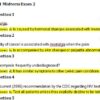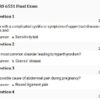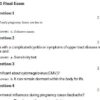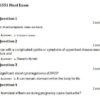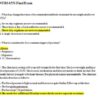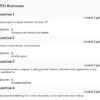Description
NURS 6551N Final Exam Week 11 – Primary Care of Women
- What is the leading cause of first-trimester maternal death?
- Lois is complaining of leg cramps during her pregnancy. What would you suggest to relieve them?
- What components make up the biophysical profile?
- Which of the following instructions should be included in the discharge teaching plan to assist the postpartal woman in recognizing early signs of complications?
- Where does edema tend to occur in the pregnant woman’s body?
- What is the general goal of surgical treatment for stress UI?
- To prevent breast trauma during the breastfeeding, the nurse practitioner should stress the importance of
- The primary endocrine disorders affecting women are diabetes mellitus and:
- Pregnant women should know that folic acid can help to prevent neural tube defects. To be most effective, women should take folic acid:
- A 28-year-old pregnant patient gives a history of smoking 1 pack of cigarettes per day (1 PPD). The nurse practitioner is accurate when she tells the patient that cigarette smoking is associated with:
- Optimal weight gain during pregnancy is based on the woman’s prepregnant BMI and:
- What is the most typical schedule of prenatal care in the first 28 weeks of pregnancy?
- Nancy is concerned that her new breastfed baby is not getting enough fluid. What do you tell her so that she can assess for an adequate intake?
- At what time during pregnancy does nausea typically occur?
- An autosomal recessive disorder such as cystic fibrosis is expressed in the offspring when:
- The side effect of medroxyprogesterone (Depo-Provera) that often leads women to discontinue use is:
- Qualitative urine testing for hCG (human chorionic gonadotropin) can be done reliably ________ days after implantation of the blastocyst (fertilized egg).
- How are pregnancy-related DHA (docosahexaenoic acid) needs best met?
- An 18-year-old mother who is breastfeeding her 2-week-old infant, expresses concern about how much milk the baby is getting. Which of the following parameters is reassuring to the nurse practitioner that the infant is receiving adequate nutrition?
- Spontaneous abortion refers to the loss of a fetus of less than
- What is considered to be a common trigger of psoriasis?
- Which of the following dietary changes would you recommend Heather, who is experiencing nausea during her firsts trimester?
- What tends to cause acne in adolescence?
- Which of the following antibiotics is the best choice for acute pyelonephritis when it occurs during the seventh month of pregnancy?
- A 45-year-old patient voices concern about her hot flashes and irregular menstral periods. What diagnostic test would the nurse practitioner order to confirm the beginning of menopause?
- What is the recommended timing for gestational diabetes screening?
- A 20-year-old female patient presents with lower abdominal pain, moderate vaginal bleeding, and right shoulder pain. Her blood pressure is 85/50 mmHg, pulse 140, respirations 28, and temperature 98 deg. F. She has a history of pelvic inflammatory disease (PID). Her urine pregnancy test is positive. Which of the following is the most likely diagnosis?
- What is a contributor to the increased incidence of heartburn during pregnancy?
- The reason most often cited to explain why women who have had a usual length of stay and normal delivery discontinue breastfeeding before 8 weeks postpartum is:
- After 28 weeks’ gestation, all women should perform fetal movement counts (FMCs). Which of the following statements regarding FMCs is true?
- RhoGAM is indicated for an Rh-negative mother:
- Which of the following does not increase a woman’s risk for developing cervical cancer?
- The nurse practitioner is discussing contraception options to be used during lactation with a 24-year-old pregnant patient. Which of the following methods of contraception would not be appropriate for use while breastfeeding?
- Patricia presents for her regularly scheduled prenatal visit at 34 weeks’ gestation. During the interview, you determine that Patricia has not felt fetal movement for the past week. On examination, you are unable to auscultate the fetal heart tones. Which of the following would be useful in the diagnosis of an intrauterine fetal death?
- Which of the following is the best description of the Lamaze method of childbirth education?
- Sandra, who is 5 months pregnant and of average height and weight, asks you how many extra calories she should be adding to her diet per day. You tell her to add:
- What is an indication of the second stage of labor?
- Heather, who is 5 weeks pregnant, is nauseous. She asks you how long this will last. You tell her nausea usually disappears by the
- After how many weeks’ gestation is a pregnancy loss considered a fetal death or stillbirth?
- What is the rationale for anemia seen throughout gestation?
- How does women’s anatomy make them more susceptible to UTIs?
- During nursery rounds, you examine a 12-hour-old newborn. The infant has a yellow tint to the skin and sclera. What lab test will you order to further evaluate this infant?
- Minnie is experiencing Braxton Hicks contractions. What should she do?
- Marci has had several abortions in the past and has been unable to carry a pregnancy to full term because of an incompetent cervix. She states that the physician mentioned cerclage to her and asks you what that means. You tell her that cerclage is:
- The Papanicolaou (Pap) smear report on a 36-year-old female patient indicates atypical squamous cells of undetermined significance (ASCUS). Which of the following constitutes appropriate care for this patient?
- Uncomplicated acute bacterial cystitis occurs in women who:
- Jack is 4 weeks old and has oral candidiasis because his mother had an intrauterine infection that was successfully treated with antibiotics. What would you anticipate treating Jack with?
- When is a pregnant woman at risk for developing congenital rubella syndrome?
- What distinguishes pyelonephritis from cystitis?
- A 23-year-old pregnant patient who works as a secretary is a large law firm is seeing the nurse practitioner for early pregnancy evaluation and education. It would be very important to teach this patient about:
- Check out our latest courses on PSYC 502 Week 3.


